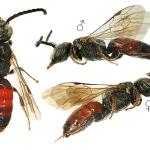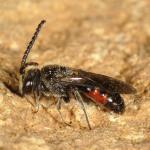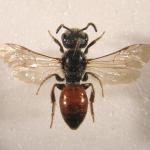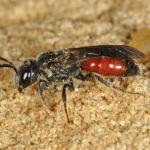Sphecodes subquadratus SMITH 1845; Sphecodes maculatus LEPELETIER 1841; Sphecodes gibbus ephippium incertus SICHEL 1865; Sphecodes gibbus ephippium nigrescens SICHEL 1865; Sphecodes gibbus ephippium testaceipes SICHEL 1865; Sphecodes gibbus ephippium subvar. rufipes SICHEL 1865, nec Smith 1853; Sphecodes gibbus ephippium subquadratus subvar. dubius SICHEL 1865; Sphecodes ruficrus DALLA TORRE 1896, nec Erichson 1835; Sphecodes hanuman NURSE 1903; Sphecodes caucasicus ssp. cephalotes MEYER 1920; Sphecodes monilicornis nigerrima BLÜTHGEN 1927; Sphecodes quadratus ssp. cephalotiformis PITTIONI 1950; Sphecodes smyrnaensis MEYER 1920
Found throughout Britain, Ireland, the Isle of Man, the Isles of Scilly and the Channel Islands.
A Palaearctic species, known from Europe as far north as central Finland; also found in central Asia and North Africa (S Roberts, pers. comm.).
This species is not regarded as scarce or threatened.
Found in a wide variety of habitats, including heaths, calcareous grassland, woodland edges and gardens.
A univoltine species. The female flies from mid April to early October and the male, late June to early October.
It parasitises Halictus rubicundus (Christ), and Lasioglossum species such as malachurum (Kirby), albipes (Fabricius), calceatum (Scopoli), laticeps (Schenck), xanthopus (Kirby) and zonulum (Smith).
The bee visits a variety of plant families in Britain, for nectar only: Asteraceae, Apiaceae, Rosaceae, Campanulaceae and Euphorbaceae.
No data available.
2016





